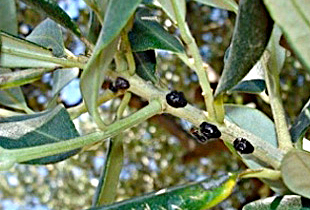

SPECIES: Saissetia oleae ( order Hemiptera)
COMMON NAME: "Cocciniglia mezzo grano di pepe" (Italy)
SIZE: The adult female is about 5 mm in length
LIFECYCLE: The Saissetia oleae overwinters as a 2nd and 3rd stage nymph. It can also overwinter, rarely, as immature female, or egg-laying female. From females overwintering in warmer climates with mild winters, nymphs can be produced even before the end of winter. The development of overwintering nymphs is completed between the spring and summer (late June / early July). In this period the females, which gradually become adults, reproduce by parthenogenesis and lay eggs that are kept protected by the mother's body. The egg-laying is completed, in most cases, towards the end of July; the moment of greatest appearance of nymphs is generally between the second half of July and August. Most of the nymphs are intended to overwinter. Only the first nymphs, those born in the spring, manage to complete their development and reproduce in the late summer or early autumn. These can produce a second generation, or spend the winter as immature females. Therefore, Saissetia oleae can produce 1 or 2 generations per year.
FEATURES: oval, with strongly convex body that carries convex shapes and, on the back, a figure similar to an "H". It is brown in colour. During oviposition, the color darkens and becomes almost black. The male, which has wings, is rarely seen. The nymphs are born yellowish, becoming darker during development.
HABITAT: Saissetia oleae is widespread in areas with mild climates, but is also present in colder regions, where it lives mainly in greenhouses. Infestations and the development of the pest are helped by a mild winter climate, humid summers, and temperatures that are not too high. High temperatures, low humidity, and intense sunlight, cause high mortality of nymphs. Finally, excessive use of nitrogen fertilizers can greatly increase the population of the pest. The most affected plants are: Olive, citrus, Ornamental (Oleander, Pittosporum, euonymus, Palm, etc.).
DIET/DAMAGE: The damage is seen on the branches and leaves, and is caused by the feeding of the insect. Scale insects use the undersides of leaves, along the midrib; the attack removes sap causing hindrance to the development of the buds, and reduced production of fruits that often fall as a result. In general there is a deterioration of the plant, with dieback of branches and leaves; the consequences of the attack also affect production in future years. Moreover, Saissetia oleae produces abundant honeydew which also causes asphyxiation and burns (due to the lens effect), encourages ants (which stimulate production of even more honeydew), and promotes the establishment of sooty mould that causes further damage.
I want to sterminate itNeed to disinfest your plants? Gallura Disinfestazioni has the solution against parasites. Contact us for a free consultation and quote!